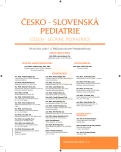Drug induced aseptic meningitis and Lyell syndrome: Rare causes of headache and exanthema in adolescents
Authors:
N. El-Lababidi; K. Ruczaj; P. Klement; P. Pokorná; J. Zeman
Authors‘ workplace:
Klinika dětského a dorostového lékařství UK 1. LF a VFN, Praha
přednosta prof. MUDr. J. Zeman, DrSc.
Published in:
Čes-slov Pediat 2014; 69 (4): 234-240.
Category:
Case Report
Overview
A 16-year old girl with a 6 year history of valproate (Depakine Chrono) therapy for absence type epilepsy and 5 days history of Biseptol (Trimethoprim/Sulphamethoxazole) treatment for urinary tract infection (E. coli >106) developed an itchy papular exanthema of the neckline area with subsequent merging and spreading to the lower parts of the body. On the 7th day of Biseptol treatment, the girl was extremely restless, confused and complained of body pain, mainly of the head and the skin. A qualitative consciousness disorder kept progressing. Positive irritation signs of the meninges were present and hemorrhagic purpura developed on the abdomen and legs. A neurological examination confirmed the meningeal syndrome with a finding of strikingly generalized entire body painfulness and muscle weakness mainly of the lower limbs. The cerebrospinal fluid analysis revealed lymphocytic pleocytosis (CSF-Protein 0.96 g/l, reference range <0.2; Leucocytes 44/3, reference range <3/3) compatible with the diagnosis of aseptic meningitis. Due to negative culture, serological and molecular investigations, dermatomyositis or Guillain-Barré syndrome were considered. However, the clinical course of the disease and the results of skin biopsy with the focal desquamation of the upper layer of the epidermis with discrete lymphoplasmocytic infiltrates surrounding the blood vessels and lymphocytes in the interstitium led to the final diagnoses of drug induced aseptic meningitis and toxic epidermal necrolysis.
Both diseases represent a rare complication of the adverse effects of pharmacotherapy in childhood and should be considered within the scope of the differential diagnostics in a child with aseptic meningitis and skin symptoms of unknown origin.
Key words:
drug induced aseptic meningitis, Stevens-Johnson syndrome, Lyell syndrome, toxic epidermal necrolysis, trimethoprim/sulphamethoxazole, cytochrome P450, CYP2C9 L.
Sources
1. Bai MM, Glass S. Drug-induced aseptic meningitis: An uncommon, challenging diagnosis. In: Fontana, Calif: Kaiser Permanente Medical Center, Residency & Staff Physician, Dec 2005. http://www.hcplive.com/publications/Resident-and-Staff/2005/2005-12/2005-12_02.
2. Redman IV RC, Miller JB, Hood M, et al. Trimethoprim-induced aseptic meningitis in an adolescent male. Pediatrics 2002; 110: e26.
3. Jolles S, Carrock Sewell WA, Leighton C. Drug-induced aseptic meningitis diagnosis and management. Drug Saf 2000 Mar; 22 (3): 215–226.
4. Jacewicz M. Aseptic meningitis. Porter RS (ed). The Merck Manual. 19th ed. Merck (2011; July 20): 1–3754. ISBN-10: 0911910190.
5. Cascella C, Nausheen S, Cunha BA. A differential diagnosis of drug induced aseptic meningitis. Infect Med 2008; 25: 331–334.
6. Biosca M, de la Figuera M, et al. Aseptic meningitis due to trimethoprim-sulfamethoxazole. J Neurol Neurosurg Psychiatry 1986 Mar; 49 (3): 332–333.
7. Moris G, Garcia-Monco JC. The challenge of drug-induced aseptic meningitis. Arch Intern Med 1999; 159: 1185–1194.
8. Heinige P, Sádlo M, Fajt M, et al. Raritní příčina meningitidy. První Linie 2012; 2 (1): 30–31.
9. Kapla J, Dostál V, Szanyi J. Aseptická meningitida vyvolaná léky. Klin Mikrobiol inf Lék 2003; 9 (2): 91–93.
10. Harr T, French LE. Toxic epidermal necrolysis and Stevens-Johnson syndrome. Orphanet J Rare Dis 2010; 5: 39.
11. Hamm RL. Drug hypersensitivity syndrome: Diagnosis and treatment. J Am Coll Clin Wound Spec 2011 Dec; 3 (4): 77–81.
12. Wetter D, Camilleri MJ. Clinical, ethiological and histopathologic features of Stevens-Johnson syndrome during 8-year period at Mayo Clinic. Mayo Clin Proc 2010 Feb; 85 (2): 131–138.
13. River Y, Averbuch-Heller L, et al. Antibiotic induced meningitis. J Neurol Neurosurg Psychiatry 1994 Jun; 57 (6): 705–708.
14. Pashankar D, McArdle M, et al. Co-trimoxazole induced aseptic meningitis. Arch Dis Child 1995 Sept; 73 (3): 257–258.
15. Jain KK. Drug-induced aseptic meningitis, 2011, www: http://www.medmerits.com/index.php/article/drug induced septic meningitis/P4.
16. Jain KK. Drug-iInduced Neurological Disorders. 3rd revised and expanded ed. USA: Hogrefe Publishing, 2012: 13–14. ISBN 978-0-88937-425-6.
17. Kielhofner M. Trimethoprim-sulfamethoxazole: Pharmacokinetics, clinical uses and adverse reactions. Tex Heart Inst J 1990; 17 (2): 86–93.
18. Nettis E, Calogiuri G, Colanardi MC, et al. Drug-induced aseptic meningitis. Curr Drug Targets Immune Endocr Metabol Disord 2003 Jun; 3 (2): 143–149.
19. Wen X, Wang J-S, Backman JT, et al. Trimethoprim and Sulfamethoxazole are selective inhibitors od CZP2C8 and CZP2C9, respectively. Drug Metab Dispos 2002 Jun; 30 (6): 631–635.
Labels
Neonatology Paediatrics General practitioner for children and adolescentsArticle was published in
Czech-Slovak Pediatrics

2014 Issue 4
Most read in this issue
- Alagille syndrome
- Clinical and biochemical characteristics of Kawasaki syndrome in 22 children
- Drug induced aseptic meningitis and Lyell syndrome: Rare causes of headache and exanthema in adolescents
- Children´s involuntary exposure in smoking environment is even more dangerous than it has been expected
